#tuareg people
Explore tagged Tumblr posts
Text
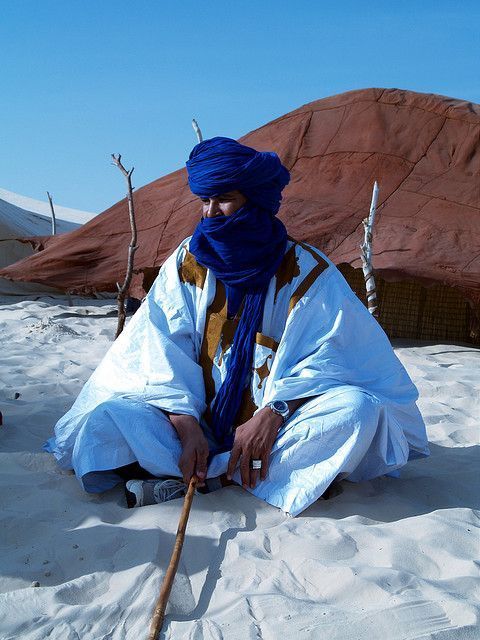
Tuareg man in Mali, wearing blue veil.
the Tuareg people are an ethnic group inhabiting the Sahara desert. Although they practice Islam, it is the men who wear veils, not women. They mostly wear blue veils which is why they are also known as blue men of Sahara.
11 notes
·
View notes
Video
youtube
Mdou Moctar - Imouhar (Official Music Video)
Imouhar is the Tuareg equivalent to "brother" or "comrade.” It’s a familial way to say “Tuareg people” that expresses a shared bond.
Taken from Mdou Moctar's upcoming album 'Funeral for Justice' out on Matador Records, May 3, 2024
14 notes
·
View notes
Photo
In the Encyclopedia of Clothing and Fashion (2005), Leslie W. Rabine describes the boubou as:
“the classic Senegalese robe, worn by both men and women all over West Africa and in West African diasporic communities of Europe and the United States. Sewn from a single piece of fabric, the boubou is usually 59 inches (150 cm) wide and of varying lengths. The most elegant style, the grand boubou, usually employs a piece of fabric 117 inches (300 cm) long and reaches to the ankles. Traditionally, custom-made in workshops by tailors, the boubou is made by folding the fabric in half, fashioning a neck opening, and sewing the sides halfway up to make flowing sleeves. For women the neck is large and rounded; for men it forms a long V-shape, usually with a large five-sided pocket cutting off the tip of the ‘V.’ When stiffly starched and draped over the body, the boubou creates for its wearer the appearance of a stately, elegant carriage with majestic height and presence. Men wear the classic boubou with a matching shirt and trousers underneath. Women wear it with a matching wrapper or pagne and head-tie.”
This traditional blue indigo-dyed boubou (Fig. 1) is decorated with geometric and figural embroidery which shows the prestige and importance of the wearer. These Islamic motifs were for protection and this boubou was only worn for special occasions.
In the Berg Encyclopedia of World Dress and Fashion: Africa (2010), Babatunde Lawal explains a possible origin for the boubou:
“It has been suggested that the Berbers/Tuaregs from North Africa might have introduced some of these robes and trousers to western and central Africa in the course of the trans-Saharan trade that started before the Christian era and lasted until the late nineteenth century. Some of the earliest evidence of the flowing robe in sub-Saharan Africa comes from a ninth-century c.e. burial site excavated at Igbo-Ukwu in eastern Nigeria.”
This indigo-dyed cotton robe (Fig. 2) is a single piece of fabric which creates the flowing drapery on the body. There is a slit in the center where the wearers head goes through then the rest of the fabric drapes down.
The boubou can also be designed with patterns and imagery. This boubou (Fig. 3) includes alternating strips of fabric sewn together. Both fabric sections are indigo dyed, one being light blue and the other being dark to create a contrasting striped pattern. Around the squared neck hole is geometric hand-sewn embroidery in red, white, brown, and black.
While traditionally a robe for men, in the twentieth century women also began to wear a version of the boubou, as Lawal notes:
“Women sometimes wear a loose blouse or robe (called boubou in Senegambia and Mali) on top of their wrappers.”
In the Berg Encyclopedia of World Dress and Fashion: Africa (2010), Hudita Nura Mustafa explains the complexity of the boubou:
“While building upon enduring forms and values, dress also possesses a fertile capacity to evolve. For example, billowing boubous, robes of six meters (twenty feet), simply cut and often richly embroidered around the neck, are recognized the world over as traditionally West African. Yet the boubou is not a static symbol of origin but an object of dynamic dialogue between tradition and modernity, hybridity and authenticity. It was further spread by Islamization in the nineteenth century and, while the basic form stays constant, it has its own fashions.”
Mustafa further elaborates:
“Although the basic categories of dress are traditional/African and modern/European, the diversity of styles transcends this opposition. These categories are symbolized in the French suit, the attire of the civilized black Frenchman, and the embroidered boubou, the attire of the traditional Muslim man. The embroidered boubou is, and has always been, the pinnacle of prestige. African dress is associated with religious and traditional ceremonial events, domestic space, and modesty.”
This cotton boubou (Fig. 4) made for a man is embroidered with red, white and blue wool has a squared neck opening for a more masculine effect. The length of this boubou is more conservative and not particularly long and the geometric designs depicted across the front and back show how customizable this garment is.
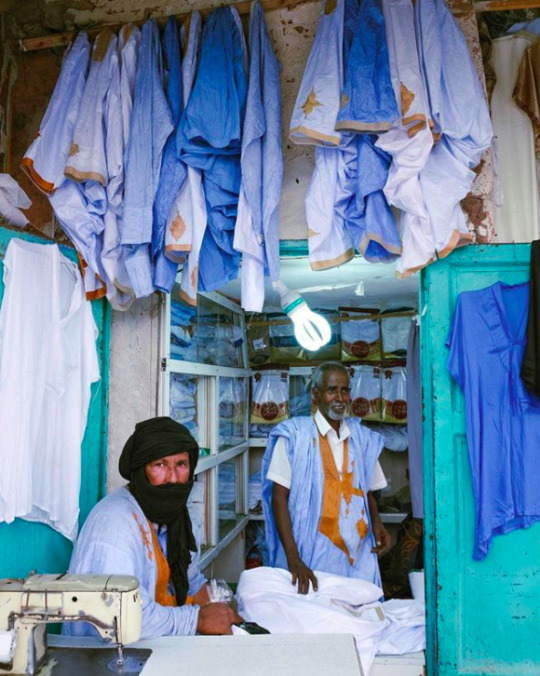
Boubou tailors in Nouakchott, Mauritania.
Instagram: ricci_s
#studyblr#history#archaeology#trade#commerce#clothing#burials#mauritania#senegal#amazigh#tuareg people#nigeria#anambra state#nouakchott#igbo-ukwu#leslie w. braine#babatunde lawal#hudita nura mustafa#trans-saharan trade#to read
106 notes
·
View notes
Text
Unveiling Goundam's Impressive Historical Mosque: A Journey through Cultures and Empires
The Goundam-Tokossel Mosque, located in the town of Goundam, Mali, stands as a testament to the rich history and diverse cultural heritage of the region. This historic mosque holds a special place in the hearts of the locals and serves as a focal point for the community. Situated in a town with a longstanding history as a center for Songhay farmers and Bozo fishing communities, as well as…
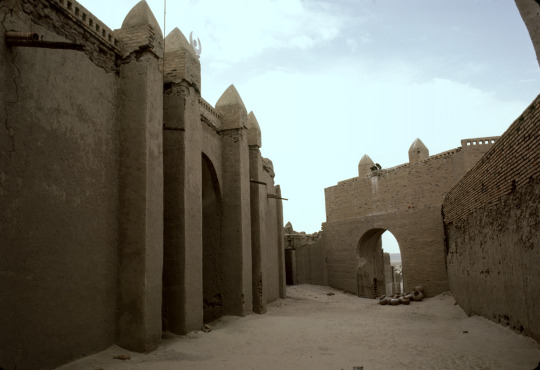
View On WordPress
#African History#Fula history#FULA PEOPLE#Goundam#Goundam-Tokossel Mosque#Mali#Mali Empire#Mali History#Maure history#Maure peoples#Tuareg#Tuareg History#Tuareg people#West African#West African history
0 notes
Text

Tifinagh alphabet, from Aghali-Zakara (1993 and 2002): Hoggar (Algeria); Aïr (Niger); Ghat (Libya); Azawagh (Niger-Mali); and Adghagh (Mali)
"The "written landscape" of the central Sahara: recording and digitising the Tifinagh inscriptions in the Tadrart Acacus Mountains" by Savino Di Lernia and Stefano Biagetti
#tifinagh#amazigh#imazighen#anthropology#writing systems#alphabet#archaeology#sahara#acacus mountains#amazigh people#tuareg#rock art#petroglyphs#kel tadrart#my upl
11 notes
·
View notes
Text
Elisabeth Sunday (African-American, born 1958) is a fine art photographer known for her powerful black and white portraits of original peoples in Africa and her Mystics and Healers portraits from SoutheastAsia and Micronesia.
She developed a technique called Field Mirror Photography and is the only person in the world who makes this type of imagery. She spent 26 years traveling to Africa and living with remote peoples including the Tuareg of the Sahara Desert in Mali, the Akan fishermen of Ghana, and the Koro Warriors in the Omo Valley of Ethiopia. She also lived with the Efe people of the Ituri Rain Forest and the !Kung San (Bushmen) of the Kalahari Desert in Botswana, and photographed the Turkana in Kenya among many other places.
https://urbanzen.com/products/grace-by-elisabeth-sunday

Grace Tuareg woman, Sahara Desert, Mali, 2008 - by Elisabeth Sunday (1958), American
124 notes
·
View notes
Text

Tuaregs in the Parisian Human Zoo
French vintage postcard, mailed in 1909
#people#the parisian human zoo#briefkaart#photography#vintage#tarjeta#1909#postkaart#french#postal#human#photo#parisian#postcard#historic#tuareg#carte postale#mailed#ephemera#sepia#berber#ethnic#ansichtskarte#postkarte#group
2 notes
·
View notes
Text

The English exonym "Blue People" is similarly derived from the indigo color of the tagelmust veils and other clothing, which sometimes stains the skin underneath giving it a blueish tint.
Another term for the Tuareg is Imuhagh or Imushagh, a cognate to the northern Berber self-name Imazighen.
4 notes
·
View notes
Text
First rain in 4 years observed by the Tuaregs in Djanet, Algeria.
4 notes
·
View notes
Text
I thought it was smart to choose Tuareg veiling as a research topic for an assignment because it's something I'm interested in and want to write about in fics, but now all I want to do is write and I have no time ;;
#there are a few things in this fandom i consider myself known for but one of those lesser-known things is#the whole headcanon backstory i came up with for yusuf -- with his mother being tuareg. i have a lot of pride for this hc lol#there HAVE been numerous fics by others where yusuf speaks tamazight. like that's not new. but i want to go deeper into his family backstor#discounting the comics -- if the movie puts joe's origins vaguely in north africa then i'm going to be headcanoning.#anyway no one asked for that long fic i'm writing about yusuf and nicolo being childhood friends in the canon universe -#- but it's all i can think of right now and i'm dyyiiiing not being able to write it#also i get embarrassed about the amount of headcanon packed into this fic but if people can write amazing long modern aus -#- which feature OCs of joe and nicky's extended families then i can do that but as a canon-divergent thing. ('trick with a knife' ily)#tidbits about yusuf's mother in the fic: her name is besma. she's tuareg from the sahara. she's the bookkeeper of the family business.#she can read and write and she teaches yusuf tamazight because he's her only child interested in it and who can pick it up so well.#why did she leave her tribe? hmm interesting question. maybe i'll finish the fic when i have time sdfgfdsdfg#i'm just talking to myself in the tags instead of doing my work lmaoo
2 notes
·
View notes
Text
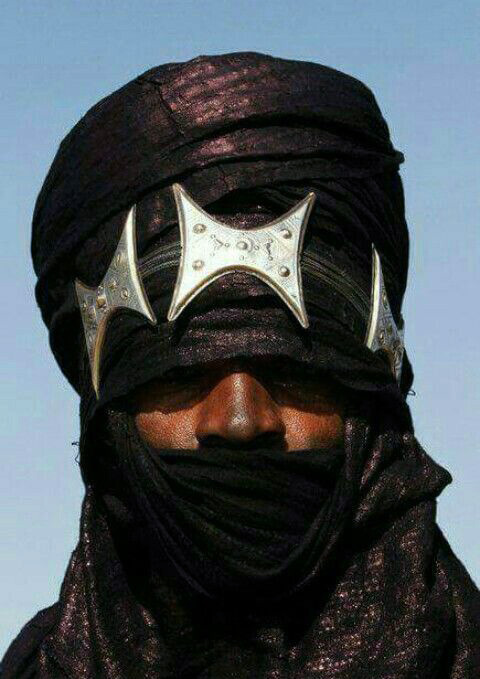
Tuareg man - annual festival in Niger
10 notes
·
View notes
Text
Loose & flowing, but covering does more than free people from unwelcome attention, it helps keep one cool & protect from sunstroke, even in such places as the Sahara desert & the Sahel. There's many more cultural groups that wear clothes in this way, even beyond the SWANA region
Heat Intolerance
This disability pride month I'd like to talk about heat intolerance. Because honestly although it's not the first health issue that presented symptoms in my life. It was the first time I was like "I don't think my body works right".
And honestly given disability pride month is during one of the hottest months in the year. It seems fitting. Especially because there's a lot of disabilities and medications that cause it.
What is heat intolerance?
Simply speaking it's the inability for the body to regulate it's temperatures especially in hot settings to cool itself down.
Why is awareness important?
Because gaslighting people or worse not providing them a place to cool down just because you "feel fine" is extremely fucking dangerous.
What are the medicines that can cause heat intolerance?
Antihistamines (Allergy medications) . Decongestants (Sudafed or any medication that has the D at the end of it). Stimulants (ADHD medications. Steroids. Caffeine.) Beta-blockers (blood pressure medications). Overactive bladder treatment. Psychiatric medications (including but not limited to medications for depression and anxiety). Pain relievers. Antibiotics.
What medical conditions can cause heat intolerance?
EDS (Elhers-Danlos syndrome). Autism. ADHD. Migraines. Brain/spinal-cord injury. Sensory processing disorder. Chronic fatigue syndrome. Endocrin problems. POTS. Menopause. Hypothyroidism. Diabetes. Heart Disease. Multiple sclerosis. Obesity. Mental health disorders.
What should I do if I suspect I have heat intolerance?
Reduce time outside during hot months. Keep your electrolytes up. Drink plenty of water. Stay out of the sun whenever possible if outside. Be aware of the symptoms of heat exhaustion and heat stroke.
Clothes that are best worn for heat intolerance. Loose lightweight breathable fabrics. Natural fibers. Long sleeves that protect from sunburn as sunburns will increase your risk. Light clothes that reflect light. Wide brimmed hats that shade the face and neck.
Cool. So what are those symptoms I'm supposed you be looking for?
Headaches. Excessive fatigue. Mood changes. Muscle cramping or weakness. Nausea/ vomiting. Rapid heartbeat. Excessive sweating or not sweating at all.
When should I do to the doctor?
If you suspect you have heat intolerance you can go to your PCP to discuss what medications you may be on and what you can do about it. Otherwise, please go to the emergency room if you have symptoms of heat stroke.
This is good information and all but why are you making this post?
To raise awareness. Not just for the people that have it but weren't aware of what it was called. But for all of the idiots that tried to gaslight me when I was in school because I was like "I don't think this is normal. Every time we do our mile run outside I vomit all over the place but other kids aren't doing that."
Also because people always blame me for over heating if I wear long sleeves or pants. I always like to take notes from what people in the middle east wear because they literally live in the excessive heat and spend long hours in the excessive heat. Often in clothing that covers most of their body. They've gotta know what they're doing, right?
I have some type of xenophobic comment about why people from the middle east cover up
Shut the fuck up 😊
-fae
#see Amazigh people of all shades#the Tuareg & Fula (including Wodaabe) plus Hausa#to name but a few cultural groups
10K notes
·
View notes
Text

The next Arthurian knight that refutes the misconception that every character in the Arthurian mythos had to be British or otherwise exclusively Western European.
Morien was a Knight of the Round Table whose life was narrated in the 13th century Arthurian poem “Moriaen,” written in the Middle Dutch. His father was the knight Aglovale, and his mother—a princess from a “Moorish” land. Just like the common imagery of Arthur’s court doesn’t have a strictly defined era or cultural affiliation (you’ll see hundreds of paintings of 6th century British knights wearing 17th century French armour), this image represents Morien as more of a legendary figure, combining regionally accurate elements in a bit of an anachronistic fashion. One of the first cultures to be referred to as Moors by the European Christians were the Maghrebine Berber people, giving some context to which region Morien's mother could be from. Amazigh-style weapons served as a basis for his weapons, while Tuareg dyeing techniques the design of his clothing. The description of his “Moorish” clothes and his armour as black as a raven reminds me of the beautiful indigo fabrics of the Tuareg people, which can appear to shine like raven feathers. His sword is barely visible, but it is based on the flyssa, an Amazigh traditional sword. He also holds an adarga, the Amazigh leather shield, which was actually so good at—well, being a shield—that it was adopted by many cultures of Europe because of its efficacy.
5K notes
·
View notes
Text

Ubari oasis in the Libyan section of the Sahara desert, belongs to Tuareg people
221 notes
·
View notes
Text
Characters reconnecting with their ancestral cultures in an interplanetary setting
@pixiedustandpetrichor asked:
Hi! I am writing a novel with three main female characters in an interplanetary setting. They grow up as orphans in an Irish-coded country and as children are mostly exposed to solely that culture, but they leave after becoming adults. Character A is Tuareg-coded, B Mongolian-coded, and C is Germanic-coded. It isn’t central to the story, but I would like them to get in touch with/learn more about their ancestral cultures, especially in terms of religion. A does this by actually visiting the planet her parents came from, but B and C do not. What can I do to depict their relationships with said cultures and their journey to reconnect with them? Would it be realistic for each of them to have different mixed feelings about participating in these cultures and for them to retain some sense of belonging to the culture they grew up in as well? Thank you for your time.
Hello, asker! WWC doesn’t have Tuareg or Mongol mods at the moment, so we're not able to speak to the specifics of cultural and religious reconnection for these particular groups. Still, I want to take this opportunity to provide some general context and elements to consider when writing Tuareg-coded characters, or other characters from groups that have experienced colonization in the real world. My fellow mods will then share thoughts about cultural reconnection in general and with respect to Germanic heritage in particular.
Drawing inspiration from groups that have experienced colonization
As you’re probably aware, the Tuareg are an ethnic group indigenous to North Africa. As with many indigenous groups, they have experienced colonization multiple times over the course of their history. Colonization often leads to the loss or erasure of certain aspects of culture as the colonized people are pressured to conform to the culture of the dominant group. In many cases, it’s near impossible to say what the ancestral culture of a colonized group was prior to colonization.
When coding a fictional culture based on a group that was colonized in the real world, it's important to ask questions about:
Which aspects of culture you're portraying
Where these aspects come from
Whether you're ready to tackle their implications for the world you're building
It’s not necessarily wrong to use elements of coding that draw from cultural aspects influenced by colonization. As I said, it can be very difficult, even impossible, to portray a “pure” culture as it would have been had colonization not occurred–because we simply can’t know what that alternate history would look like, and because so much has been lost or intentionally suppressed that the gaps in our knowledge are too wide to breach. But it’s important to be aware of where these cultural elements are coming from.
Where is your coding coming from and what are the implications?
For example, while the Tuareg today are majoritarily Muslim, this was not the case prior to the Arab conquest of North Africa. Some elements of Tuareg culture today, such as tea ceremonies, are derived from the influence of Arab and Muslim culture and likely did not exist prior to the 20th century. As you’re developing the culture of the Tuareg-coded group in your fictional setting, you have to decide whether to include these elements. There is no right answer–it will depend on what you’re trying to do and why.
Is your setting in our far future, in which case we can assume your Tuareg-coded group is distantly related to today’s Tuareg?
In that case, they will probably have kept many cultural aspects their ancestors acquired through their interactions with other cultures around them–including cultural groups that colonized them. They may–let’s build hopeful worlds!–have reclaimed aspects of their ancestral culture they’d been forced to abandon due to colonization. They may also have acquired new aspects of culture over time. This can be very fun to explore if you have the time and space to do so.
I would recommend speaking with Tuareg people to get a better grasp of how they see their culture evolving over the next however many centuries or millennia, what they wish to see and what seems realistic to them.
Alternatively, maybe your setting is a secondary world unrelated to ours and you only want to draw inspiration from the real-world Tuareg, not represent them exactly. In that case, you need to decide which period of history you’re drawing from, as Tuareg culture is different today from what it was 50 years ago, and different still from 200 years ago or 1000 years ago. You’ll need to research the historical period you’re choosing in order to figure out what was happening at that time and what the cultural influences were. If it’s pre-colonial, you’ll probably want to avoid including cultural elements influenced by colonization from groups that arrived later on.
Finally, if the time period you’re drawing from is post-colonial:
Are you planning to account for the effects of colonization on Tuareg culture?
Will you have an in-world equivalent for the colonization that occurred in real life?
For example, will the Tuareg-coded characters in your world be from a nomadic culture that was forced to become sedentary over the years and lost much of their traditions due to colonial pressure to conform?
Where did this pressure come from in your world–is it different from what happened in ours? If so, how different? And what are the consequences?
Writing about colonization can be quite the baggage to bring into a fictional setting. I’m not saying it can’t be done, but it will certainly require sensitivity and care in portraying it.
In summary: think it through
I’m not saying all this to discourage you, but to point out some of the considerations at play when drawing inspiration from a real-life culture that has experienced colonization. Similar challenges arise for coding based on any other indigenous group in the world.
My advice to you, then, is to first sit down and decide where and when in history your coding is coming from, and what you’re trying to achieve with it. This will help you figure out:
which elements of contemporary Tuareg culture are pertinent to include
How much your coding will be influenced by the Tuareg’s real-life history
To what extent that will inform the rest of the world you’re creating
This, in turn, may help in deciding how to portray your character’s reconnection journey.
Again, I am not Tuareg and this is by no means meant to be an exhaustive list of considerations for writing Tuareg-coded characters, only a few places to start.
If any Tuareg or Amazigh readers would like to chime in with suggestions of their own, please do. As always, please make sure your comments adhere to the WWC code of conduct.
- Niki
Pulling from diaspora and TRA narratives of cultural reconnection
Marika here: This ask plotline could also pull directly from diaspora and TRA narratives of cultural reconnection. Many diaspora and TRA cultural reconnection stories are, in effect, about navigating the difficult process of resuscitating, or renewing ties to culture using limited resources in environments that often lack necessary cultural infrastructure or scaffolding.
See this question here to the Japanese team for suggestions of how to handle such a storyline in a similar sci-fi setting.
More reading: Japanese-coded girl from future
-Marika
Reconnecting with German heritage
Hi, it’s Shira. I’m not sure whether German-Jewish counts as Germanic for the purposes of your post but since German Jews were more assimilated than other Ashkies, Germanness does feel real and relevant to my life (especially because my father worked there for approximately the last decade of his life.) NOTE: when I see “Germanic” vs German I think of cultures from 1500 years ago, not 100-200 years ago, so I can’t help you there, but I’d be surprised as a reader if a character focused on that for reconnection to the exclusion of the 19th century etc.
People in the United States specifically, reconnecting with German heritage, often lean into Bayerischer/Bavarian kitsch, I’ve noticed. Personally, though, what I find most relevant is:
1. The food (although I’ve come to learn that what I grew up eating was closer to veal/chicken scallopini than actual schnitzel because it was drenched in lemon, but I do like the other foods like the potato salad and sweet and sour red cabbage etc.) Your character could try making one of these “ancestral” foods as a way to reconnect?
2. The classical music, because I’m a second generation professional musician – if character C plays an instrument, leaning into that might be meaningful (Beethoven, Bach, Brahms, Mendelssohn, Clara Schumann and her husband Robert, etc.)
3. The nature, especially specifics that I enjoyed during my time there – personally, I loved the bright pink flowers all over the chestnut trees, but there are a lot of choices especially because of the Alps. If C is an artist maybe they can sketch something Germany-related from old photographs they found on the Space Internet?
I think it is VERY realistic for the characters to remain connected to the culture in which they were raised, by the way, whether or not they have positive feelings about it. Culture isn’t an inherited trait. Sure, if they want to completely walk away, they can, but I bet there are still ways it will creep back in without them realizing it simply because it’s really hard to have universal knowledge of the origins of all our quirks. Plus, not everyone feels alienated from their raised-culture just because they’re genetically something else.
P.S. There is also Oktoberfest, which I don’t really get into but is a thing, and beer, which is another point of German cultural pride.
German gentiles, weigh in – y’all have your own stuff, I know! OH YEAH so for German Christians, Christmas “markets” are a whole thing. That’s worth looking up.
–S
What do you mean by Germanic?
Hello it’s Sci! I had to study German history for my historical fantasy novel set in the late 18th century Holy Roman Empire. I am not sure what is meant by Germanic as that can encompass a variety of things.
Germanic people: from the Classical Period of Roman Empire and early Middle Ages. Similar to Mod Shira, I unfortunately can’t help very much here.
The Germanosphere: regions that spoke German, which includes modern day Germany, Austria/Hungary, Switzerland, Lichtenstein, Belgium, and Luxembourg. I generally define this as the regions captured in the Hapsburg Empire along with Switzerland usually encompassing “Central Europe.”
Modern German national identity (i.e. German): post Napoleon and the Congress of Vienna (> 1815) only including the territory of modern day Germany.*
I ask this because modern German national identity is surprisingly recent since Germany only popped up in 1871 under Otto von Bismarck. Previously, Germany was divided into smaller states and city states as a very decentralized region under the German Confederation and before that, the Holy Roman Empire. Depending on the era, you can see different conflicts and divides. During the early days of the Protestant Reformation started by Martin Luther, the northern and southern German territories generally split along Protestant-Catholic lines. The 18th century saw Austria and Prussia as the foci of global power who warred against each other even though both were part of the Holy Roman Empire.
Other states and city-states like Baden-Wurttemberg or Saxony sometimes had power but it was typically more localized compared to Austria. Post-WW2, you saw the split of Germany into West Germany run under capitalism and East Germany run under communism as a satellite Soviet state leading to more modern cultural divides. Due to heavy decentralization historically, each region had its own character with religious and cultural divides.
Assuming that the Germanic character is not from the classical period or early Middle Ages but not from the 19th century either, you can include your character reconnecting to classical folklore like that of Krampus (if they’re Christian), German literature and music like the works of Johann Wolfgang von Goethe or Mozart, or German philosophy like Immanuel Kant.
*A major wrinkle: German royals and nobility married into other states and nations frequently with Britain and Russia being notable examples. In Britain, the House of Hanover took over after the Stuart House died without clear direct heirs. When Queen Victoria married the German prince Albert, they celebrated Christmas with a tree and brought the German tradition of a Christmas tree to Britain and the British Empire. Only during World War I did the royal family’s house of Hanover name change from House of Saxe-Coburg and Gotha to the more “English-sounding” Windsor. As a result, the German cultural influence may be even more widespread than we think.
However, without more specific descriptors of what Germanic means in the context of your story, it can be difficult to determine which aspects of German culture your character could reconnect to.
-Mod Sci
#culture#cultural disconnect#cultural reconnect#race coding#ethnic coding#German#Mongol#Tuareg#setting#science fiction#Jewish#Colonialism#History#North Africa#Arab#Muslim#history
355 notes
·
View notes
Text
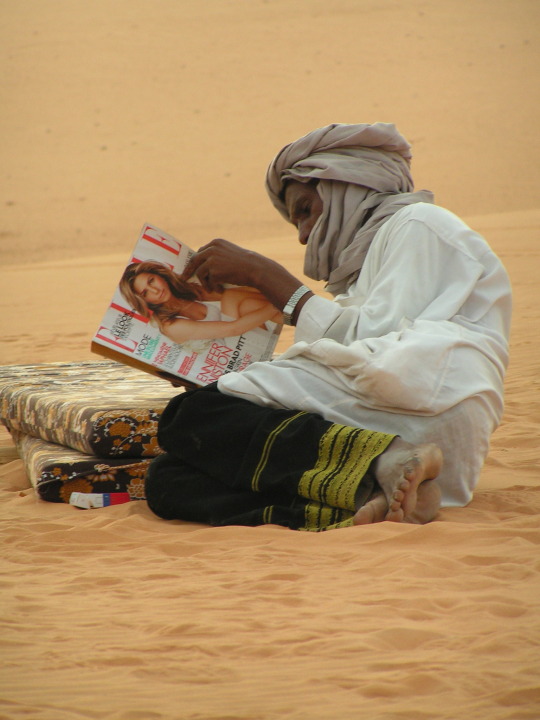
Hassan, a member of the Tuareg people, reading an issue of Elle Magazine in Ubari, Lybia
248 notes
·
View notes